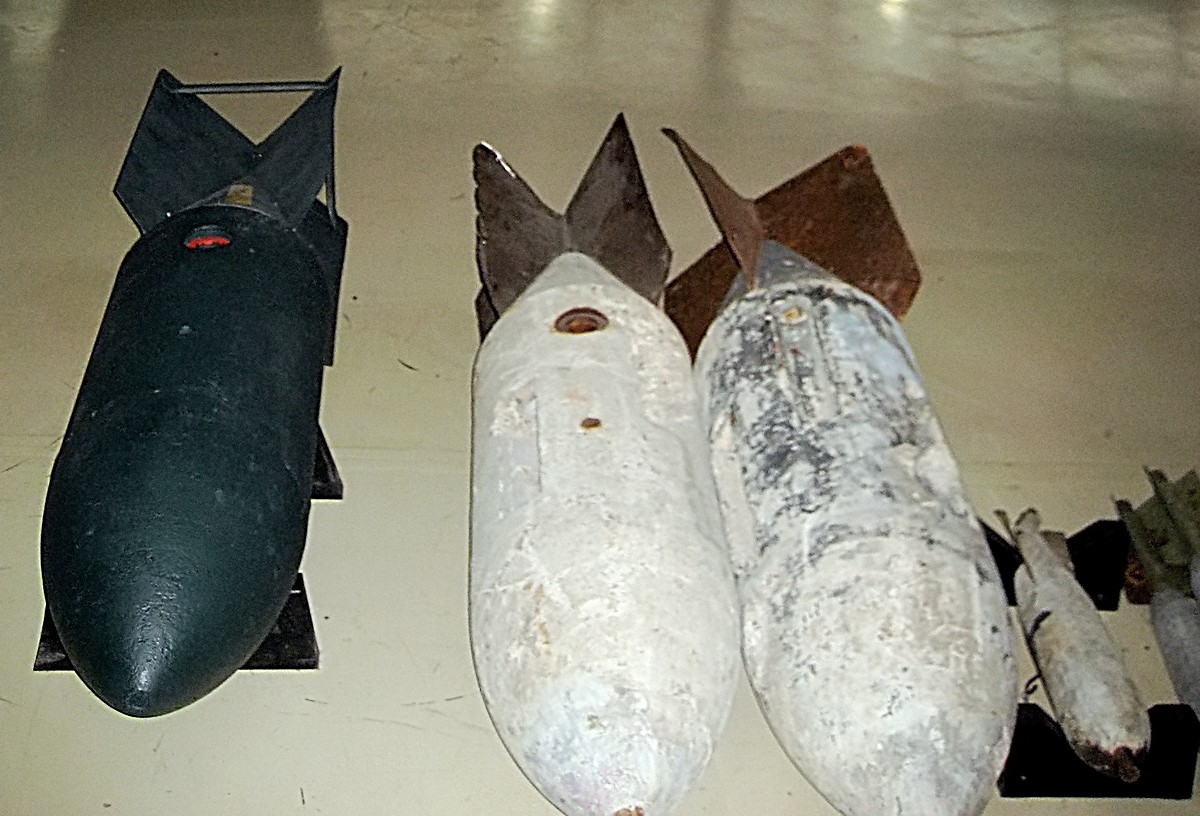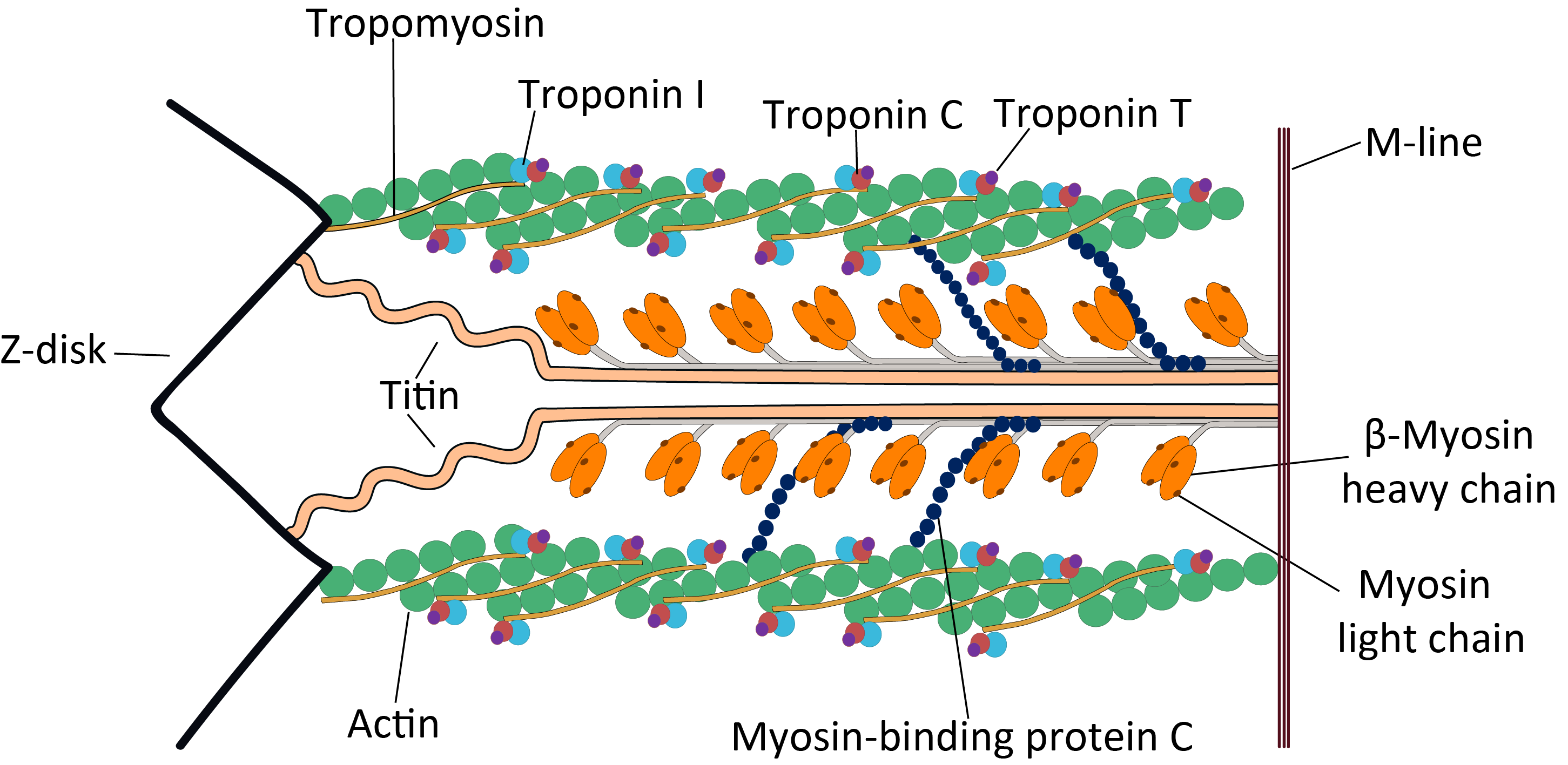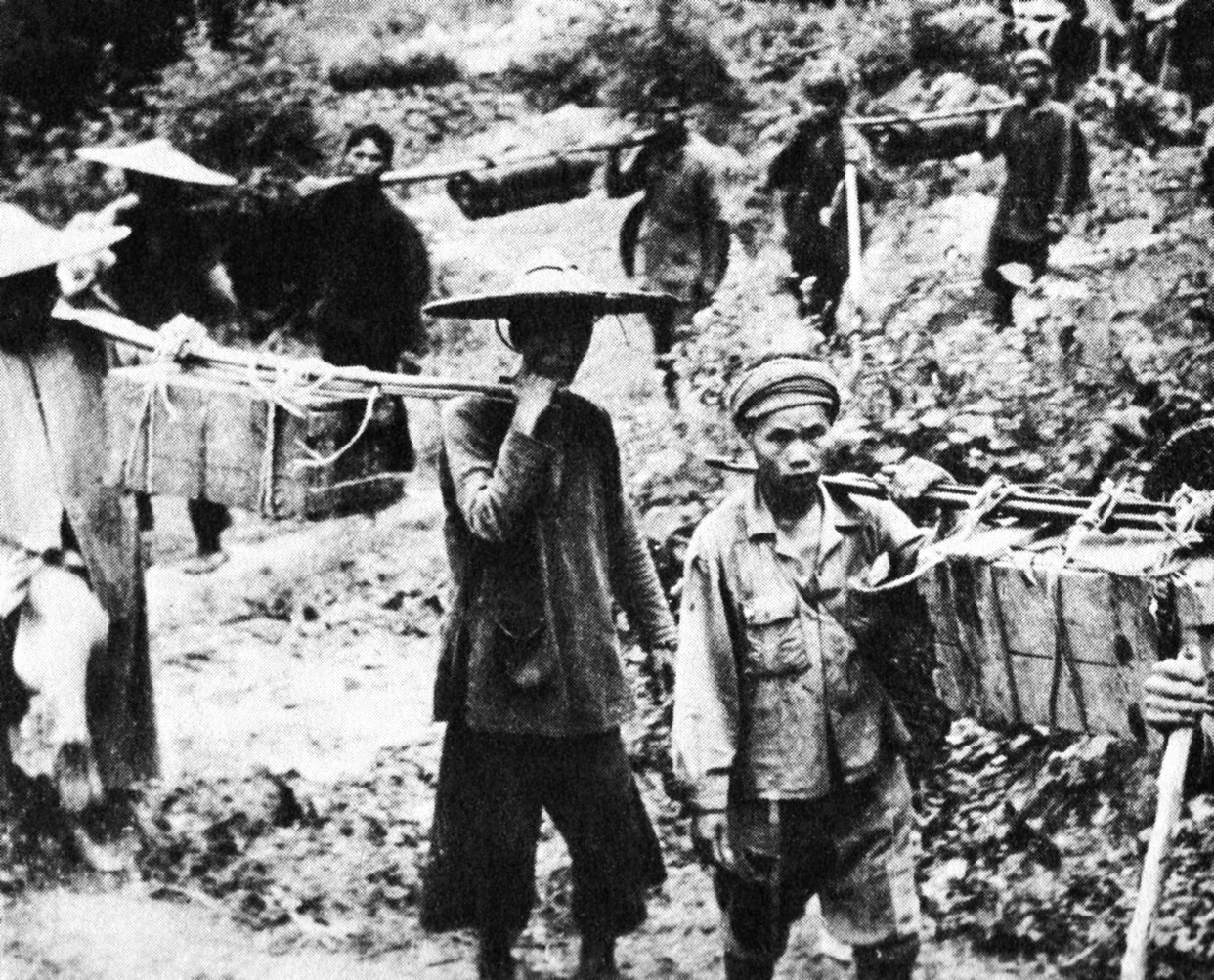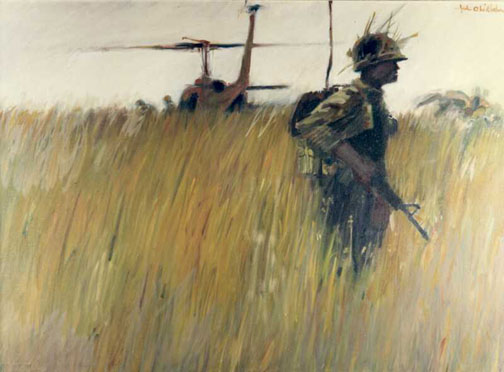|
M121 (bomb)
The M121 was a very large air dropped bomb used by the U.S. military during the Vietnam War. Originally developed from the British World War II-era Tallboy bomb to be dropped from the Convair B-36 bomber, it weighed 10,000 lb (4,500 kg) and contained an 8,050 lb (3,650 kg) Tritonal warhead. Production of the M121 ceased in 1955, but stockpiles were retained until the Vietnam War. Vietnam War In December 1967, the U.S. Air Force began a testing program to use large bombs for explosively clearing jungle areas for landing of helicopters. After tests in the United States, the U.S. Army began dropping the bombs using CH-54 helicopters. Use of the helicopters was expensive, time consuming and inefficient due to the CH-54's limited range. In October 1968, a C-130 crew from the 29th Tactical Airlift Squadron of the 463rd Tactical Airlift Wing flew a series of test drops while under the guidance of MSQ-77 radar controllers; additional test drops were made in Decembe ... [...More Info...] [...Related Items...] OR: [Wikipedia] [Google] [Baidu] |
Aerial Bomb
An aerial bomb is a type of Explosive weapon, explosive or Incendiary device, incendiary weapon intended to travel through the Atmosphere of Earth, air on a predictable trajectory. Engineers usually develop such bombs to be dropped from an aircraft. The use of aerial bombs is termed aerial bombing. Bomb types Aerial bombs include a vast range and complexity of designs. These include unguided Unguided bomb, gravity bombs, guided bombs, bombs hand-tossed from a vehicle, bombs needing a large specially-built delivery-vehicle, bombs integrated with the vehicle itself (such as a glide bomb), instant-detonation bombs, or delay-action bombs. As with other types of explosive weapons, aerial bombs aim to kill and injure people or to destroy materiel through the projection of one or more of blast, fragmentation, radiation or fire outwards from the point of detonation. Early bombs The first bombs delivered to their targets by air were single bombs carried on unmanned Incendiary ballo ... [...More Info...] [...Related Items...] OR: [Wikipedia] [Google] [Baidu] |
Aircrew
Aircrew are personnel who operate an aircraft while in flight. The composition of a flight's crew depends on the type of aircraft, plus the flight's duration and purpose. Commercial aviation Flight deck positions In commercial aviation, the crew responsible for operating and controlling the aircraft are called ''flight crew''. Some flight crew position names are derived from nautical terms and indicate a rank or command structure similar to that on ocean-going vessels, allowing for quick executive decision making during normal operations or emergency situations. Historical flightdeck positions include: * Captain, the pilot Pilot-in-Command and highest-ranking member or members of a flight crew. * First officer (FO, also called a co-pilot), another pilot who is normally seated to the right of the captain. (On helicopters, an FO is normally seated to the left of the captain, who occupies the right-hand seat.)Smith, PatrickPatrick Smith's Ask The Pilot: When a Pilot ... [...More Info...] [...Related Items...] OR: [Wikipedia] [Google] [Baidu] |
Aluminium
Aluminium (or aluminum in North American English) is a chemical element; it has chemical symbol, symbol Al and atomic number 13. It has a density lower than that of other common metals, about one-third that of steel. Aluminium has a great affinity towards oxygen, passivation (chemistry), forming a protective layer of aluminium oxide, oxide on the surface when exposed to air. It visually resembles silver, both in its color and in its great ability to reflect light. It is soft, magnetism, nonmagnetic, and ductility, ductile. It has one stable isotope, 27Al, which is highly abundant, making aluminium the abundance of the chemical elements, 12th-most abundant element in the universe. The radioactive decay, radioactivity of aluminium-26, 26Al leads to it being used in radiometric dating. Chemically, aluminium is a post-transition metal in the boron group; as is common for the group, aluminium forms compounds primarily in the +3 oxidation state. The aluminium cation Al3+ ... [...More Info...] [...Related Items...] OR: [Wikipedia] [Google] [Baidu] |
Ammonium Nitrate
Ammonium nitrate is a chemical compound with the formula . It is a white crystalline salt consisting of ions of ammonium and nitrate. It is highly soluble in water and hygroscopic as a solid, but does not form hydrates. It is predominantly used in agriculture as a high-nitrogen fertilizer. Its other major use is as a component of explosive mixtures used in mining, quarrying, and civil construction. It is the major constituent of ANFO, an industrial explosive which accounts for 80% of explosives used in North America; similar formulations have been used in improvised explosive devices. Many countries are phasing out its use in consumer applications due to concerns over its potential for misuse.Ammonium nitrate sold by ton as U.S. regulati ... [...More Info...] [...Related Items...] OR: [Wikipedia] [Google] [Baidu] |
Trinitrotoluene
Troponin T (shortened TnT or TropT) is a part of the troponin complex, which are proteins integral to the contraction of skeletal and heart muscles. They are expressed in skeletal and cardiac myocytes. Troponin T binds to tropomyosin and helps position it on actin, and together with the rest of the troponin complex, modulates contraction of striated muscle. The cardiac subtype of troponin T is especially useful in the laboratory diagnosis of heart attack because it is released into the blood-stream when damage to heart muscle occurs. It was discovered by the German physician Hugo A. Katus at the University of Heidelberg, who also developed the troponin T assay. Subtypes * Slow skeletal troponin T1, TNNT1 (19q13.4, ) * Cardiac troponin T2, TNNT2 (1q32, ) * Fast skeletal troponin T3, TNNT3 (11p15.5, ) Reference values The 99th percentile cutoff for cardiac troponin T (cTnT) is 0.01 ng/mL. The reference range for the high sensitivity troponin T is a normal 52 ng/L. Backgr ... [...More Info...] [...Related Items...] OR: [Wikipedia] [Google] [Baidu] |
BLU-82
The BLU-82B/C-130 weapon system, known under program "Commando Vault" and nicknamed " Daisy Cutter" in Vietnam for its ability to flatten a section of forest into a helicopter landing zone, was an American conventional bomb, delivered from either a C-130 or MC-130 transport aircraft or a CH-54 Tarhe heavy-lift helicopter from the 1st Air Cavalry. A total of 225 were constructed. It was successfully used during military operations in Vietnam, the Gulf War and Afghanistan. The BLU-82 was retired in 2008 and replaced with the more powerful GBU-43/B MOAB. Overview The designation "BLU" stands for Bomb Live Unit, as opposed to "BDU" (Bomb Dummy Units) used for practice. Originally designed to create an instant clearing in the jungles of Vietnam, the BLU-82B/C-130 was test-dropped there from a CH-54 Tarhe "Flying crane" helicopter. Later it was used in Afghanistan as an anti-personnel weapon and as an intimidation weapon because of its very large blast radius (variously repor ... [...More Info...] [...Related Items...] OR: [Wikipedia] [Google] [Baidu] |
Military Assistance Command, Vietnam
The U.S. Military Assistance Command, Vietnam (MACV) was a joint-service command of the United States Department of Defense, composed of forces from the United States Army, United States Navy, and United States Air Force, as well as their respective special operations forces. MACV was created on 8 February 1962, in response to the increase in United States military assistance to South Vietnam. MACV was implemented to assist and oversee the Military Assistance Advisory Group (MAAG) Vietnam while the Viet Cong insurgency was under way. It was reorganized on 15 May 1964 and absorbed MAAG Vietnam when the deployment of combat units became too large for the advisory group to control. General Paul D. Harkins was the first commanding general of MACV (COMUSMACV), and was previously the commander of MAAG Vietnam. After reorganization he was succeeded by General William Westmoreland in June 1964, followed by General Creighton W. Abrams (July 1968) and General Frederick C. Weyand (June ... [...More Info...] [...Related Items...] OR: [Wikipedia] [Google] [Baidu] |
Excedrin (brand)
Excedrin is an over-the-counter headache pain reliever, typically in the form of tablets or caplets. It contains paracetamol, aspirin and caffeine. It was manufactured by Bristol-Myers Squibb until it was purchased by Novartis in July 2005 along with other products from BMS's over-the-counter business. As of March 2015, GSK holds majority ownership of Excedrin through a joint venture transaction with Novartis. On July 18, 2022, GSK spun off its consumer healthcare business (including Excedrin) to Haleon. The brand became known for advertisements where it cured especially unpleasant and excruciating headaches (called "Excedrin headaches" in the ads of 1970s, and later called "Excedrin tension headaches"). In 2007, the brand branched out into marketing for other types of pains with the introduction of Excedrin Back & Body, without caffeine. Principles of work Excedrin is a combination medication composed of acetaminophen, aspirin, and caffeine. These medications treat migraine ... [...More Info...] [...Related Items...] OR: [Wikipedia] [Google] [Baidu] |
Booby Trap
A booby trap is a device or setup that is intended to kill, harm or surprise a human or an animal. It is triggered by the presence or actions of the victim and sometimes has some form of bait designed to lure the victim towards it. The trap may be set to act upon trespassers that enter restricted areas, and it can be triggered when the victim performs an action (e.g., opening a door, picking something up, or switching something on). It can also be triggered by vehicles driving along a road, as in the case of improvised explosive devices (IEDs). Booby traps should not be confused with mantraps which are designed to catch a person. Lethal booby traps are often used in warfare, particularly guerrilla warfare, and traps designed to cause injury or pain are also sometimes used by criminals wanting to protect drugs or other illicit property, and by some owners of legal property who wish to protect it from theft. Booby traps which merely cause discomfort or embarrassment are a popular f ... [...More Info...] [...Related Items...] OR: [Wikipedia] [Google] [Baidu] |
Viet Cong
The Viet Cong (VC) was an epithet and umbrella term to refer to the communist-driven armed movement and united front organization in South Vietnam. It was formally organized as and led by the National Liberation Front of South Vietnam, and conducted military operations under the name of the Liberation Army of South Vietnam (LASV). The movement fought under the direction of North Vietnam against the South Vietnamese and United States governments during the Vietnam War. The organization had both guerrilla and regular army units, as well as a network of cadres who organized and mobilized peasants in the territory the VC controlled. During the war, communist fighters and some anti-war activists claimed that the VC was an insurgency indigenous to the South that represented the legitimate rights of people in South Vietnam, while the U.S. and South Vietnamese governments portrayed the group as a tool of North Vietnam. It was later conceded by the modern Vietnamese communist lead ... [...More Info...] [...Related Items...] OR: [Wikipedia] [Google] [Baidu] |
Vietnam People's Army
Vietnam, officially the Socialist Republic of Vietnam (SRV), is a country at the eastern edge of mainland Southeast Asia, with an area of about and a population of over 100 million, making it the world's List of countries and dependencies by population, fifteenth-most populous country. One of two communist states in Southeast Asia, Vietnam shares land borders with China to the north, and Laos and Cambodia to the west. It shares Maritime boundary, maritime borders with Thailand through the Gulf of Thailand, and the Philippines, Indonesia, and Malaysia through the South China Sea. Its capital is Hanoi and its largest city is Ho Chi Minh City. Vietnam was inhabited by the Paleolithic age, with states established in the first millennium BC on the Red River Delta in modern-day northern Vietnam. Before the Han dynasty's invasion, Vietnam was marked by a vibrant mix of religion, culture, and social norms. The Han dynasty annexed Northern and Central Vietnam, which were subs ... [...More Info...] [...Related Items...] OR: [Wikipedia] [Google] [Baidu] |
Landing Zone
In military terminology a landing zone (LZ) is an area where aircraft can land. In the United States military, a landing zone is the actual point where aircraft, especially helicopters, land (equivalent to the commonwealth landing point.)The Handbook Of The SAS And Elite Forces. How The Professionals Fight And Win. Edited by Jon E. Lewis. p.289-Tactics And Techniques, Landings And Raids On Enemy Territory. Robinson Publishing Ltd 1997. ISBN 1-85487-675-9 In commonwealth militaries, a landing zone is the cartographic (numeric) zone in which the landing is going to take place (e.g., a valley). The landing area is the area in which the landing is going to take place (e.g., the field where the aircraft are to land). The landing point is the actual point on which aircraft are going to land (e.g., a point of the field). Each aircraft has a different landing point. Identifying an LZ from the air Landing areas are most commonly marked by colored smoke. The standard procedure is for troo ... [...More Info...] [...Related Items...] OR: [Wikipedia] [Google] [Baidu] |






